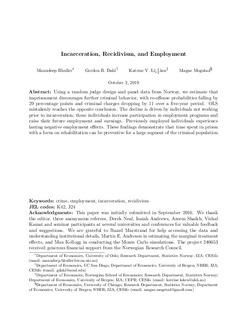| dc.contributor.author | Bhuller, Manudeep | |
| dc.contributor.author | Mogstad, Magne | |
| dc.contributor.author | Dahl, Gordon Boyack | |
| dc.contributor.author | Løken, Katrine Vellesen | |
| dc.date.accessioned | 2019-10-03T11:41:29Z | |
| dc.date.available | 2019-10-03T11:41:29Z | |
| dc.date.created | 2019-09-19T13:12:55Z | |
| dc.date.issued | 2020 | |
| dc.identifier.issn | 0022-3808 | |
| dc.identifier.uri | http://hdl.handle.net/11250/2620071 | |
| dc.description.abstract | Using a random judge design and panel data from Norway, we estimate that
imprisonment discourages further criminal behavior, with re-offense probabilities falling by
29 percentage points and criminal charges dropping by 11 over a five-year period. OLS
mistakenly reaches the opposite conclusion. The decline is driven by individuals not working
prior to incarceration; these individuals increase participation in employment programs and
raise their future employment and earnings. Previously employed individuals experience
lasting negative employment effects. These findings demonstrate that time spent in prison
with a focus on rehabilitation can be preventive for a large segment of the criminal population | nb_NO |
| dc.language.iso | eng | nb_NO |
| dc.subject | crime | nb_NO |
| dc.subject | employment | nb_NO |
| dc.subject | incarceration | nb_NO |
| dc.subject | recidivism | nb_NO |
| dc.title | Incarceration, Recidivism, and Employment | nb_NO |
| dc.type | Journal article | nb_NO |
| dc.type | Peer reviewed | nb_NO |
| dc.description.version | acceptedVersion | nb_NO |
| dc.subject.nsi | VDP::Social science: 200::Economics: 210::Economics: 212 | nb_NO |
| dc.source.journal | Journal of Political Economy | nb_NO |
| dc.identifier.doi | 10.1086/705330 | |
| dc.identifier.cristin | 1726739 | |
| cristin.unitcode | 191,30,0,0 | |
| cristin.unitname | Institutt for samfunnsøkonomi | |
| cristin.ispublished | false | |
| cristin.fulltext | preprint | |
| cristin.qualitycode | 2 | |
